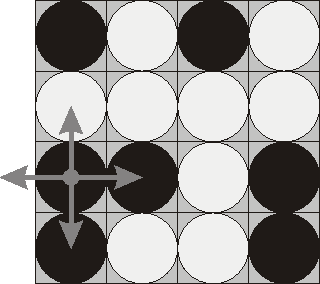Description
Flip game is played on a rectangular 4x4 field with two-sided pieces placed on each of its 16 squares. One side of each piece is white and the other one is black and each piece is lying either it's black or white side up. Each round you flip 3 to 5 pieces, thus changing the color of their upper side from black to white and vice versa. The pieces to be flipped are chosen every round according to the following rules:
 Consider the following position as an example:
Consider the following position as an example:
bwbw
wwww
bbwb
bwwb
Here "b" denotes pieces lying their black side up and "w" denotes pieces lying their white side up. If we choose to flip the 1st piece from the 3rd row (this choice is shown at the picture), then the field will become:
bwbw
bwww
wwwb
wwwb
The goal of the game is to flip either all pieces white side up or all pieces black side up. You are to write a program that will search for the minimum number of rounds needed to achieve this goal.
- Choose any one of the 16 pieces.
- Flip the chosen piece and also all adjacent pieces to the left, to the right, to the top, and to the bottom of the chosen piece (if there are any).
 Consider the following position as an example:
Consider the following position as an example:
bwbw
wwww
bbwb
bwwb
Here "b" denotes pieces lying their black side up and "w" denotes pieces lying their white side up. If we choose to flip the 1st piece from the 3rd row (this choice is shown at the picture), then the field will become:
bwbw
bwww
wwwb
wwwb
The goal of the game is to flip either all pieces white side up or all pieces black side up. You are to write a program that will search for the minimum number of rounds needed to achieve this goal.
Input
The input consists of 4 lines with 4 characters "w" or "b" each that denote game field position.
Output
Write to the output file a single integer number - the minimum number of rounds needed to achieve the goal of the game from the given position. If the goal is initially achieved, then write 0. If it's impossible to achieve the goal, then write the word "Impossible" (without quotes).
Sample Input
bwwb bbwb bwwb bwww
Sample Output
4
这个题我用的深搜,把图直接转化成一维。因为每个点只有翻转和不翻转两种状态。所以可以直接从头搜到尾即可;
每次搜索两种状态。
#include <iostream>
#include<stdio.h>
#include<stdlib.h>
#include<string.h>
#include<queue>
using namespace std;
const int inf=0x3f3f3f3f;
int tu[16];
int ans;
int panduan()
{
int i;
int sum=0;
for(i=0;i<=15;++i)sum+=tu[i];
if(sum==0||sum==16)return 1;
else return 0;
}
void change(int x)//翻转操作
{
tu[x]=!tu[x];
if(x-4>=0)tu[x-4]=!tu[x-4];
if(x+4<=15)tu[x+4]=!tu[x+4];
if(x%4>0)tu[x-1]=!tu[x-1];
if(x%4<3)tu[x+1]=!tu[x+1];
}
void dfs(int x,int sum)
{
if(panduan())
{
ans=min(ans,sum);
}
if(x>=15)return ;
dfs(x+1,sum);
change(x+1);//翻转
dfs(x+1,sum+1);
change(x+1);//恢复状态
}
int main()
{
char t[4][5];
int i,j;
for(i=0;i<4;++i)scanf("%s",t[i]);
int cnt=0;
for(i=0;i<4;++i)
{
for(j=0;j<4;++j)
{
if(t[i][j]=='b')tu[cnt++]=1;
else tu[cnt++]=0;
}
}
if(panduan())printf("0\n");
else
{
ans=inf;
dfs(-1,0);
if(ans!=inf)
printf("%d\n",ans);
else printf("Impossible\n");
}
return 0;
}























 749
749

 被折叠的 条评论
为什么被折叠?
被折叠的 条评论
为什么被折叠?








